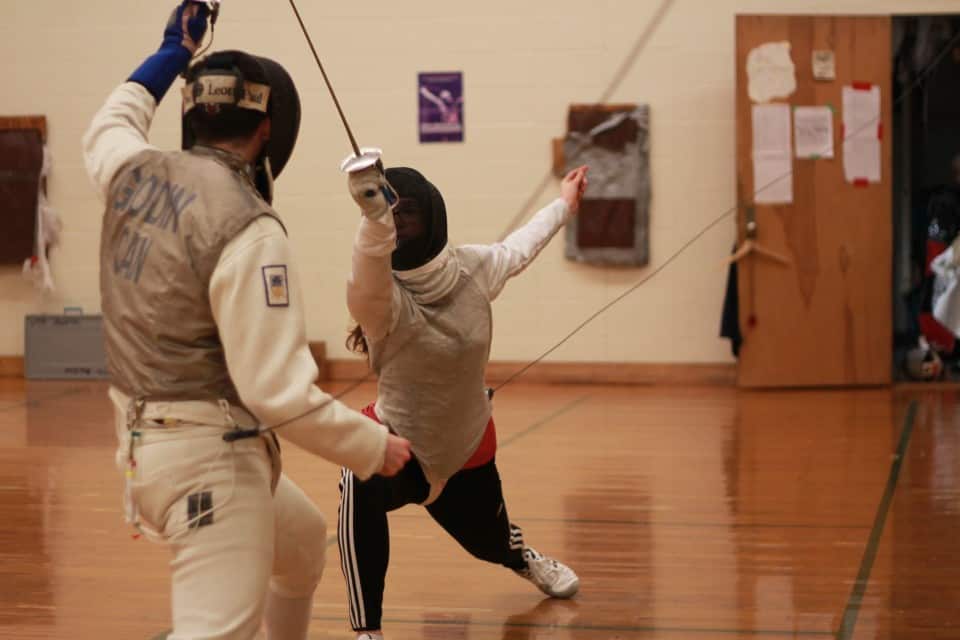I started fencing in 2008 after my parents instructed me to take up some form of physical activity. What began as an acquiescence to fitness soon became an exhilarating experience, a sport that was mentally and physically demanding. The mythology of fencing captivates many, yet it remains uncommon enough to warrant classification as an obscure sport. I spoke to Tom Feore, Varsity fencer and third-year neuroscience and philosophy student, to bust some myths and share some insights.
“A lot of people have this sort of conception of fencing as this romantic, [anachronistic practice] — you’ve seen The Princess Bride, you’ve seen any rapier kind of swashbuckling film — and people think that’s what it is. It’s not,” said Tom, adding that the technicalities of fencing set it apart from stage fighting.
In fencing, there are three weapons and each has a different set of rules that govern their use: the foil (a light thrusting weapon and a common weapon of instruction), the épée (a heavy thrusting weapon), and the sabre (the cutting weapon). For foil, the target area — parts of the body on which a hit will score points — is the neck, chest, and groin; in épée; the whole body is fair game, and for sabre, everything from the waist up counts.
Foil and sabre are both ‘priority weapons’ and are played according to a rule known as the ‘right of way.’ “When you have a fencing match, very often two people will hit each other simultaneously, or what appears to lay observers, simultaneously,” said Tom. In circumstances when this happens, ‘right of way’ indicates that it is the job of the referee to determine which fencer initiated the attack. Sometimes the giveaway is obvious, like with a straight attack or a parried hit, but sometimes the ‘simultaneous’ contact will occur in the middle of a skirmish. “What you’re looking for would be like if I go and continue and if you stop and I capitalize on that stopping, you begin to see how tactical it is in terms of distance and time,” he said. As for the épée, there is no ‘right of way;’ if both fencers hit, they both score points.
“Other people have other sorts of ideas about it, that it’s akin to regular combat, like if I hand you a rapier you’d be competent… no,” said Tom. One of the differences between a fencing match and a fight is that in fencing, the objective is to accumulate points, which you do through hitting your opponent. Each hit scores a point. Tom emphasized that the goal of fencing is not to avoid being hit by your opponent, it’s to rack up points. Being hit is inevitable. “You see a lot of beginning fencers, they’re very difficult to fence sometimes because they fence and fight instinctively,” Tom said. “They’re wild, they don’t use the stance properly, they move reactively, they’re brutal, they’re swatting because they feel like they’re fighting.”
“If you watch a real rapier fight or if you’ve done any stage combat, you know that these things are brutal; people have daggers, people are elbowing each other in the face. [In fencing] you’re not fighting to survive,” Tom said. “I’m dancing with you. I’m not fighting.” Force alone will not bring victory. Fencing is a battle of wits as much as it is a feat of strength. “It doesn’t matter how hard you hit someone. It’s not a matter of having a high pain threshold,” he said. “It’s sort of its own inherently competitive, but strategic, physical endeavour.”
Tom described it as “all the tactics of chess with all the satisfaction of fighting, which he finds an enjoyable challenge. He called mastering the physically demanding en garde stance “ineffable” and described the reward of properly executing a strategy as “a sense of ownership.” It all requires discipline. Shockingly, you can’t just pick up a sword and expect to know how to use it.
Tom’s advice is to get the fundamentals down and appreciate their value. Up to an hour of each of Tom’s practice sessions can be devoted to strength training and footwork exercises, which he says aren’t always immediately rewarding but are absolutely crucial.
“The best fencers in the world can do whatever they want. Nine times out of ten, they win on very, very simple things because those things are there so well, they’re so smart, and if those things weren’t there exceptionally well, but they knew a whole bunch of advanced manoeuvres, they wouldn’t do nearly as well.”
It’s never too late to start fencing; Tom started fencing around the age of 15, which for many competitive fencers, is late. Some people even take it up when they come to university. If you’re learning to fence for the first time, U of T offers a beginners course. If you’re already a fencer, you can get in touch with the university’s coach or manager whose contact details are available online.


